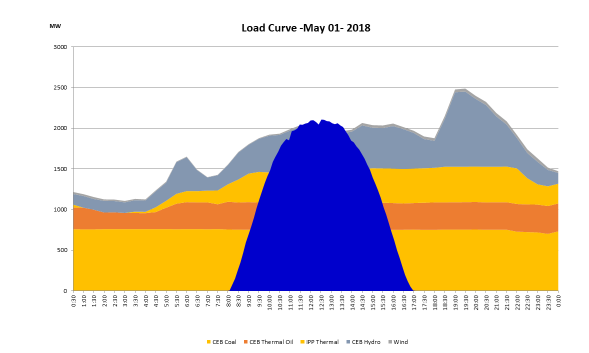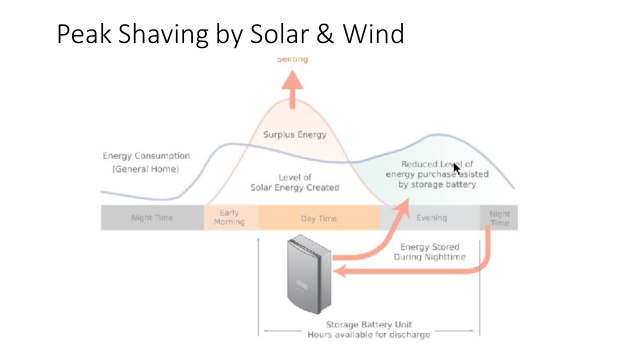The Origin and Way out of the Energy Crisis –
Part III
The way out of present crisis and a vision and strategy
for an energy secure Sri Lanka
By Eng Parakrama Jayasinghe
Introduction to the series
The subject of energy requires an in depth analysis on the aspects of background, historical events and possible strategies and programs for future energy security. These cannot be adequately treated in a single article even for a basic understanding. The first of these articles addressed the social and economic facets of energy in the current environment. The present Part II dealt with the historical events leading to present crisis and open up the opportunity to discuss the possible remedies to avoid a recurrence and ensure a energy secure Sri Lanka
This final instalment addresses the way forward for Sri Lanka to achieve the mush desired energy security in the foreseeable future.
The Way Forward for an Energy Secure Nation
Sri Lanka is dependent largely on the CEB for providing the uninterrupted electricity to the country as they hold the monopoly for the electricity sales and is the owner of the national grid. The CEB which has achieved the enviable goal of providing grid connected electricity to the whole nation appears to have a notion that any one criticizing their projected plans such as the LTEGP, not without reason, must also offer the alternative solutions. But in the same breath they insist that only the CEB possess the knowledge of the expertise to develop such plans. There is an element of truth in this, as the data available of the complex grid system and other intricacies are not available to others other than the regulator PUCSL to which the CEB is obliged by law to provide all relevant data. However it is reported that over the past year they have refused to provide such data. This is a blatant violation of the provisions of the Electricity Act. Thereby the window open to the consumer public to have even an inkling of the state of the sector which is public property is denied.
However, notwithstanding this sorry status of the behavior of an institution full under the control of engineers, it is possible to consider the many options available to Sri Lanka both on the short term, which is the urgent need, as well as for a medium to long term options. These should lead to an energy sector no longer dependent on the use of any imported fossil fuels. Such planning must emerge from a visionary national policy on the energy sector which is a crying need. The initiative of the former Minster of Power and Energy for the development of a Sri Lanka Energy Sector Development Plan for a Knowledge Based Economy 2015 to 2025 provides a glimpse of such a policy. This plan which projected an energy sector primarily targeting indigenous resources by 2030 envisages to
‘Guide the nation in its efforts to become an energy self-sufficient nation by developing full potential of renewable and other indigenous energy resources while achieving maximum energy conservation through exploration, facilitation, research & development and knowledge management’ and it is further elaborated by the Ministers Message
"We have set an ambitious goal of 100% energy self-sufficiency by 2030. As a developing economy the challenge ahead of us is enormous and I am convinced that we can reach this goal if we set our priorities right and adjust our actions along the way."
These are very laudable and for Sri Lanka eminently achievable goals, given our past record of near 100% Hydro Power contribution and nearly 50% contribution by biomass to the primary energy supply even now. Therefore, the goal of 100% renewable energy by the year 2030 as envisaged, is not the daunting task as it would appear at first sight.
The development plan also reports that “Sri Lanka has already achieved a grid connectivity of 98%, which is commendable by South Asian standards. Current total installed power generation capacity of the country is approximately 4,087 MW, consisting of 900 MW of coal power, 1,335 MW of oil burning thermal power, 1,375 MW of hydro power and 442 MW of non-conventional renewable energy sources such as wind, mini hydro, biomass and solar power plants”. The annual total electricity demand is about 10,500 GWh with a projected annual demand growth of around 4-6 % projected to reach 30,645 GWh and 5893 MW by 2030, according to the Long Term Generation Plan of the CEB. These projections have been contested based on the much lower rate of historical increase of demand than what is used in the above plan or in the previous LTEGP plans.
However this plan seems to have disappeared after the minister’s change of portfolio.
The projected Renewable Energy potential
Against this has to be viewed the projected potential of the indigenous sources of energy noted as Biomass 2400 MW, Mini Hydro 873 MW, Wind 5653 MW and Solar 6000 MW from just 1% of the scrub lands, as reported in the ADB funded assessment report.
The studies conducted by The National Renewable Energy Laboratories ( NREL) for Sri Lanka predicted a total potential of 20,000 MW of wind energy and 1885 kWh/m2/year of Solar Energy.
The Mechanical Engineering Sectional committee conducted a series of public lectures during the period 2016 to 2017 on the various aspects of Sri Lanka’s energy resources and these have now been published in written form titled “Energy Resources of Sri Lanka” which is a ready reference in minute detail of the resources available to us. (Available for reference and purchase in the IESL Library)
The opportunities for progressive actions not dependent on any imported fossil fuels for immediate development are available as noted below.
Although the immediate danger of continued power cuts over the coming months seems to have abated, the doubtful means by which such relief is gained would be an expensive option. Thus the following short term solutions deserve early consideration.
Under the present circumstances the development of the Solar PV options offers the fastest means of adding much needed additional energy input to the national grid. The Roof Top solar PV is already developed and has succeeded in adding over 200 MW in 21,000 roof top installations entirely by local service providers and Sri Lankan engineers and work force. They could be incentivized to increase their rate or additional from the current 5 MW per months, by several fold. It is necessary for the CEB to provide the incentives needed, primarily by accepting and acknowledging the relief provided by these projects at no capital cost and a guaranteed energy cost over a 20 year period. The appreciation of the benefit to the National Grid is lacking with lamentations of problems of variable nature of Solar PV, which are no longer problems for other countries. The contribution by this sector is only 2% of the total grid capacity and is not likely to pose a problems of instability for many years to come. This is confirmed by the findings of the NREL who state that until the contribution from Solar and Wind reaches 20% the present status of the grid poses no problem. The CEB engineers should take pro-active measures to make use of the interim period to tackle such issues which is already reported to be resolved in other countries.
The CEB initiated two calls for tenders for solar parks of capacity in 2016 for 60 projects of 1 MW and later for 90 projects of 1 MW in late 2017. However the rate of progress for award of tenders to the selected bidders is very slow. An acceleration of this process can ensure that a good proportion of these projects can be grid connected within a few months. Close coordination with the SEA is required to ensure that the approval process is fast tracked. The lessons learned from this tender process should be used for future calls for such offers. Until then the more pragmatic option is to maintain the NCRE tariff structure for Solar parks up to say 5 MW capacity. This level of investment could be generated in the local financial sector and help enhance the development of local expertise and board base the investments in the electricity sectors.

It is true that Solar PV without storage is available only during the day time on sunny days and thus parallel fuel based power plants are required as spinning reserves. However, with the distributed deployment of solar all over the country, there is bound to be some areas with bright sunshine while the rest of the country is under clouds. As such diversity will kick in to reduce the need for any such spinning reserve. This perception must also be contested with due consideration of the advantages that Sri Lanka already possess. We are fortunate to have major hydro schemes totaling 1350 MW already installed. As such any solar PV generation during the day is a means of conserving the water in the reservoirs which is a virtual storage already in place. The daily demand chart which the PUCSL used to publish, shown above indicates that even during the day time substantial amount of major Hydro power is being used during the day time hours. The inputs from Solar PV is the means of conserving this resource for use during the peak hours at night. The argument that the CEB is not in sole control of the water issues is not tenable. For instance the Lakshapana system has no irrigation water demands. Any demand for domestic water supply is minute. The water issues for irrigation from the Mahaweli system is needed only during some months and there is no reason why such issues cannot be made during the night time hours concurrent with the essential power generation demands. It is obvious that this excuse is being trotted out to hide some other deficiencies in the CEB grid system which needs investigation and resolving early. A more progressive approach is needed in consultation with the other state institutions to optimize the use of this valuable resource which we are fortunate to have developed. From a total installed capacity of 4087 MW major hydro provided 1350 MW. An optimal use of this valuable resource appreciating its valuable attributes of feasibility of instant deployment. Although historically our major hydro has been used as a base load resource there is the need to deploy such capacity as a mean of serving the peak demand. The question is, are there any technical impediments which needs to be addressed to achieve this objective? In the meanwhile the cost of storage batteries have been falling rapidly paralleling the price reduction of solar PV. If we succeed in developing adequate solar PV during the day to offset the use of hydro as indicated in the chart above any excess will go towards offsetting the expensive oil based IPPS in the margin. The progress of such interventions in Australia is illustrated below. Similar assessment needs to be done for Sri Lanka and appropriate measures to be initiated to optimize this option.
Demand Side Management - Nega Watts Vs Mega Watts
While we search for instant solutions to meet the energy demand, the obvious and most effective way of overcoming the problem is not receiving adequate attention. This is the aggressive implementation of energy conservation and energy efficiency measure termed Demand Side Management ( DSM ) .
A well proven and most economical means of meeting the increasing demand for electrical energy is the Energy Efficiency and Conservation measures or the Demand Side Management also called “Nega Watts”
Nega Watts is a better proposition than Mega Watts. An investment on DSM of 1-2 % of the cost of generation is estimated to yield a 25 % reduction in consumption The capital required for instituting such measures which can be implemented by the consumers themselves, is only a minor fraction of the cost of installing the additional power generation of equivalent scale, by any technology. The efficacy of this proposition has been well proven by the Sri Lanka Sustainable Energy Authority by the promotion of the adoption of CFL bulbs to replace the Incandescent bulbs some years ago. Their records show that with Sri Lanka achieving 65 % penetration of CFL bulbs the CEN saved 450 GWH of energy and the need for 300 MW of generation capacity.
While the use of CFL bulbs is now wide spread, the advent of the LED bulbs which a vey much more energy efficient and much less harmful environmentally could provide the means of achieving further reductions of similar scale. The peak demand id dominated by the domestic sector. This demand can be reduced significantly by encouraging the changeover form even the CFLs to LED bulbs. India has introduced an incentive to do so by providing LED bulbs at a mere Rs 10,00 each. There is no reason why we cannot do so we as the cost would be a mere fraction of the savings that can be made by avoiding the use of emergency power during this period. It is reported that the SLSEA has imported 10 Million LED bulbs to be distributed to the consumers at affordable prices. However, it is not known when this would be implemented.
The potential saving in the industries by the use of motors of higher efficiencies and other energy savings could be much more significant,

Peak shaving by domestic consumers with Solar PV and batteries
The above chart points out the very important intervention that could be brought in to achieve a significant reduction in the peak demand for many years to come, so as to obviate the need for any large power plants plants of any description. The two significant components of the peak demand are the domestic consumption and the system losses. While the wide spread use of LED lamps could make some impact, the domestic demand now consists of other loads such as TV , Refrigerator and perhaps even Air Conditioners. So what is needed is to get the domestic consumers off the grid at least during the peak hours. This is now eminently possible suing roof top solar PV and a limited battery storage to cover the consumption during the peak hours. The average size of the storage required for this is about 5 kWh and a solar panels of capacity 3-5 kW to accommodate the lesser usage during the day light hours while the batteries are charged. The recent decision of the CEB to allow Time of Day Metering for all domestic consumers adds further impetus for the success of this measure. But three important measures are needed to be implemented to attract adequate number of consumers to join this scheme.
1 The CEB to permit the use of Hybrid Inverters which permits the addition of battery storage under the present Surya Bala Sangraamaya schemes
2, Removal of all charges at point of import to reduce the cost of batteries. These charges levied in the mistaken notion of protecting the local battery industry which does not manufacture deep cycle batteries needed makes the current cost of batteries prohibitively expensive.
3 The possible introduction of low interest loans to cover at least the cost of batteries. If not a straight subsidy as practiced in other countries. The Victoria State in Australia provides a 50% subsidy for introduction of batteries.

If the duty anomaly is corrected and a suitable tariff is offered , even the consumers who have installed Solar PV systems under the net metering systems would readily add adequate battery capacity to relieve the burden on the grid during the peak hours. The MESC demonstrated such a system during the recent Techno exhibition. The addition of the batteries will greatly relieve the localized problems encountered by the grid in areas with high solar PV penetration as conceded by the CEB experts themselves.
This system is essentially an intervention of the consumers making them producers of electricity as well as distributed consumers, Thus this could also lead to a significant reduction of the transmission and distribution losses shown in the chart above.
This program could also be expanded to other larger consumers as well to increase the benefit to the national grid.
It will no doubt be argued that this will reduce the income for the CEB. However considering that the CEB loses money for each unit of electricity provided by them, particularly to the lower end consumers, the real impact to the national economy would be a reduction of the enormous losses incurred every year by the CEB , presently estimated to be over Rs 100 Billion for the year 2019. The much greater benefit is the delay if not the complete avoidance of the need for large power plants that the CEB is demanding for which they do not have the capital with them. Thus the benefit is in fact to the general public who will be called upon to foot the bill.
Medium and Long Term Strategies
While the above proposals are made primarily targeting the short term needs, successful implementation will naturally spill over to meet the medium term needs as well. However considering the increasing demand over the years including the possible conversion of the transport fleet to electricity, more strategies are needed to develop perhaps larger projects which may take several years for the implementation,
As stated above such project must necessity target the use of indigenous resources including the Mannar natural gas resource. The fact that Sri Lanka is endowed with a multitude of energy resources which are thankfully all renewable and environmentally benign, behooves us to target all such strategies for use of the indigenous resources. It is also necessary to keep in mind the basic principles stipulated in the Sri Lanka Energy Sector Development Plan for a Knowledge Based Economy 2015 to 2025 which can serve as the basic policy statement in the absence of a more detailed and rational energy policy. This will lead Sri Lanka to a path towards eventual status of long term energy security devoid of the need for any imported fossil fuels.
In this regard the development of larger scale solar and wind plants on one side and the parallel development of the sources of firm power by dendro energy plants must be pursued. Initial steps in this direction have already been taken by private investors who have applied for the development of over 1500 MW of solar parks of the range 2-5 MW and presently over 80 MW od dendro power. The dendro power option while having the advantage of providing firm power, is a more difficult proposition due to the need for development of the fuelwood resource. In this regard it is interesting to note that if His Excellency’s proposal to plant one Billion Gliricidia trees was pursued it would have proved adequate and sustainable fuel wood supplies for operation of 500 MW of dendro power. This would note have required any additional lands as the trees would have been planted in existing agricultural lands and home steads. The income flowing ton the rural economy by such a development would be enormous. Each 10 MW of dendro power would influx a minimum of Rs 500,000,000 to the surrounding farmers every year.
Conclusion
It is often stated strongly by the reputable energy experts that a grid supply cannot rely 100 % on renewable energy. Unfortunately such statements are made only considering the variable sources such as Wind and Solar on one hand and ignoring the fact that Sri Lanka has the reputation of depending only on the Hydro resources which is definitely a renewable resource up to about year 1995. It is only after that period that the ill-conceived dependence on imported oil came into the picture from which we are struggling to rid ourselves. On the other hand no one has proposed that this should be the strategy. Sri Lanka has made huge investments on large power plants even including the Norochcholai Coal power planet and many oil based power plants. These still have a significant residual life and such investments have to be protected. What is needed is not to make further investments on such plants anymore which have proven to be not the best solution economically or environmentally. Thus the emerging deficits should be bridged using indigenous resources. As stated earlier we are fortunate that all such resources are also renewable except perhaps the Mannar Gas resource which in any way our own resource.
It is important also to state that is it not necessary for all or any such Renewable Energy Plants to be developed by the private sector. If the CEB could accept the reality of this writing on the wall as it were, they should be the champions of this change taking up whatever is viable for them to implement on their own, as is being done in the Mannar Island. Otherwise they should have the perspicacity to leverage the interest and funds of the private sector investors while keeping to the principles stated above and in keeping with the Least Economic Cost of Generation.
The CE B is quite right to state that there are many complexities and intricacies in integrating new power plans to the national grid, which is their own expertise and mere proposals for development of different resources or technologies is not adequate. However it is also necessary for the CEB to realize that it is their mandate to develop and manage the grid to absorb such changes which are inevitable.
Therefore our appeal to or colleagues in the CEB is to wake up to the rapid changes happening worldwide and be conscious that it is in the interest of Sri Lanka to adapt and adopt such changes . We have no doubt regarding their knowledge and expertise to make this change and hope for an early acceptance of this reality.
 Eng: Parakrama Jayasinghe
Eng: Parakrama Jayasinghe
B SC, MI Mech E. FIE ( SL) P E Intl.
Co-ordinator and Compiler
